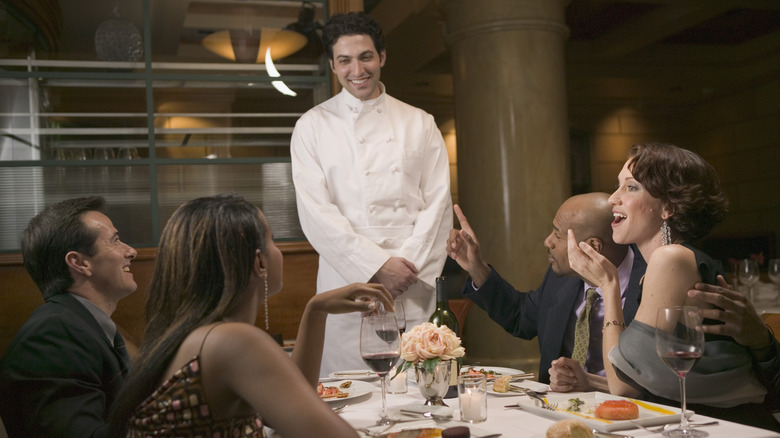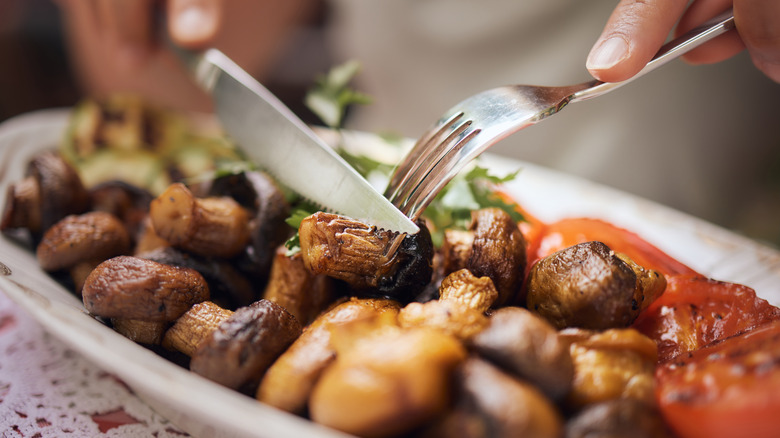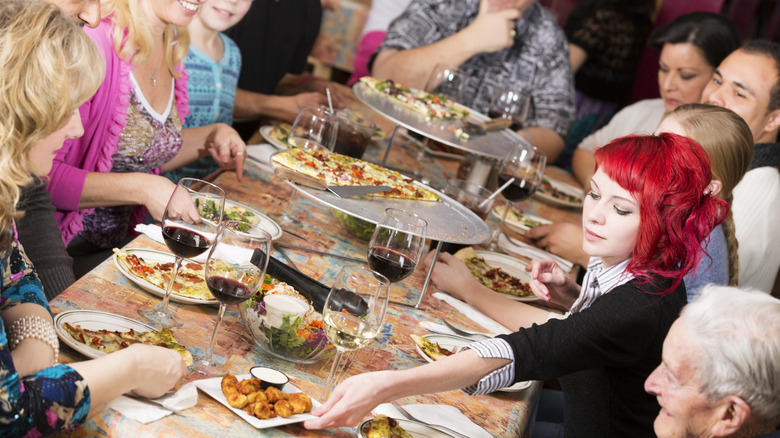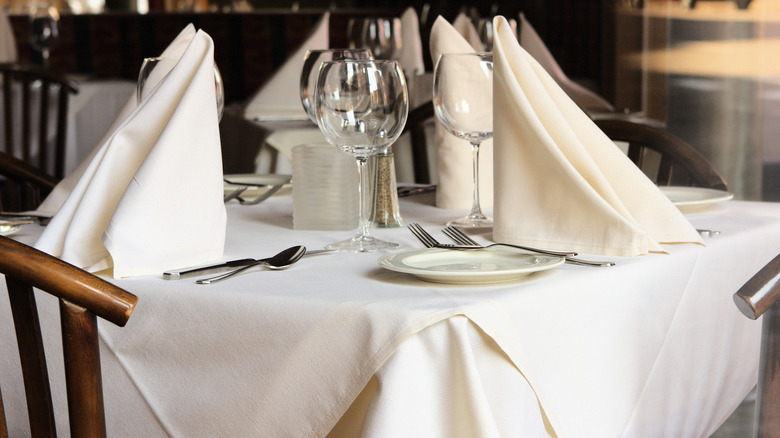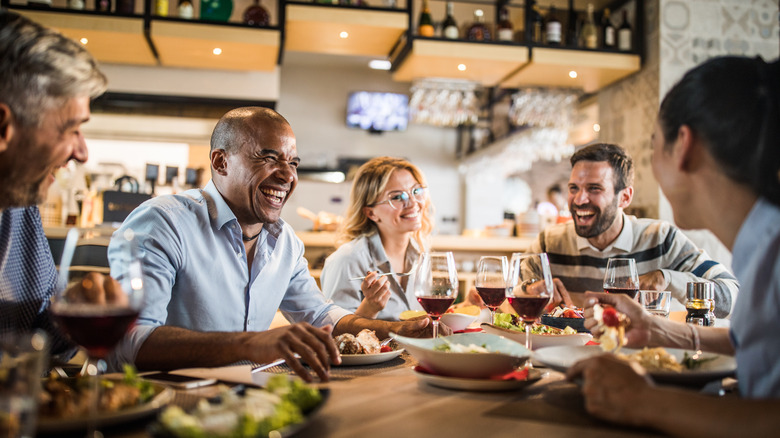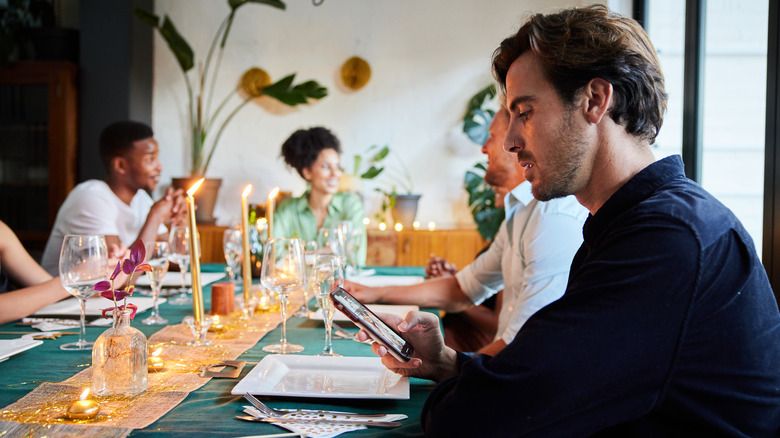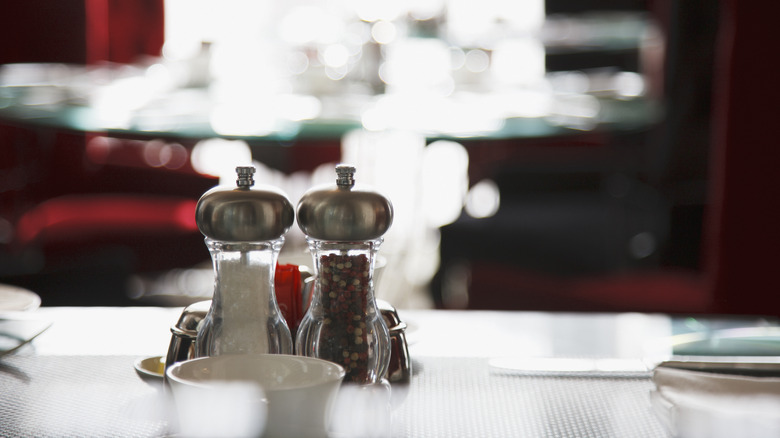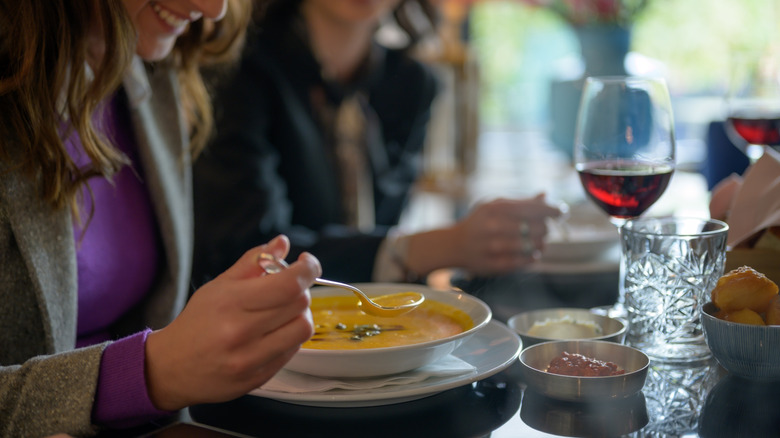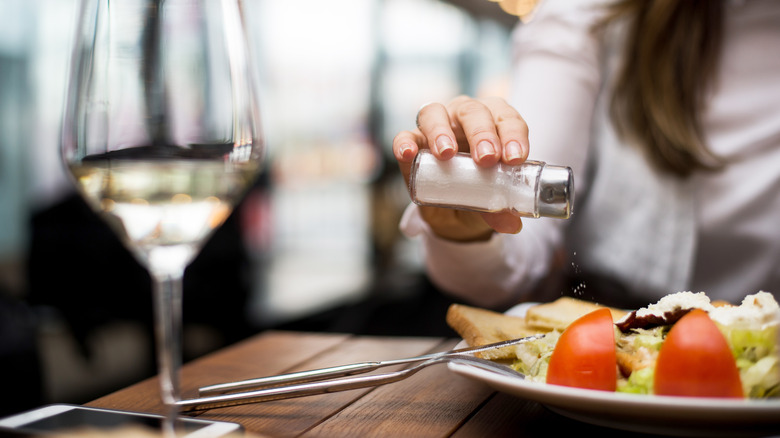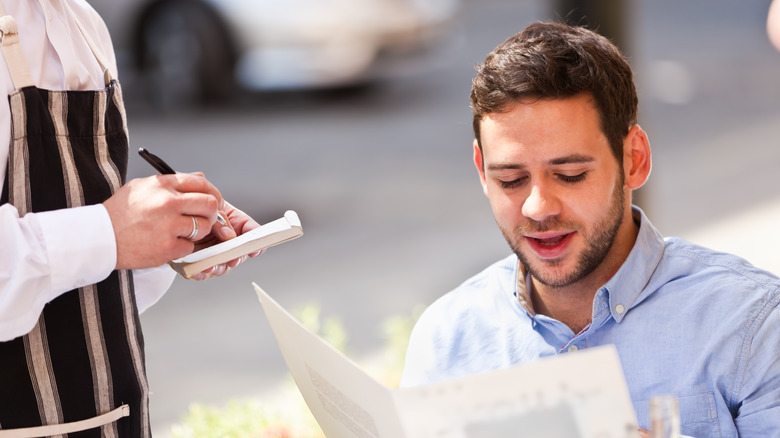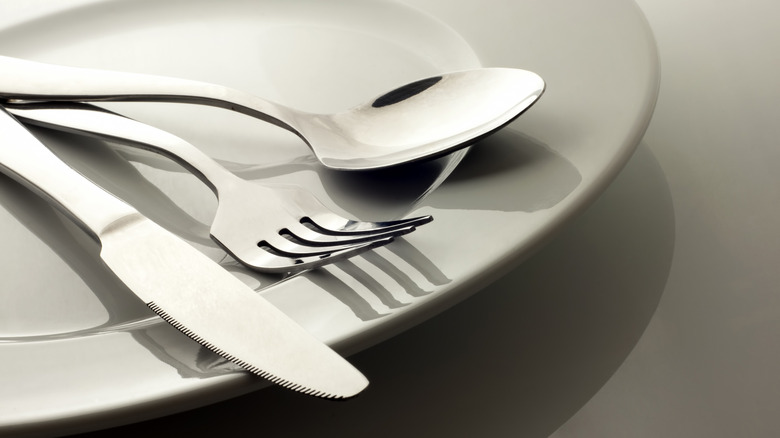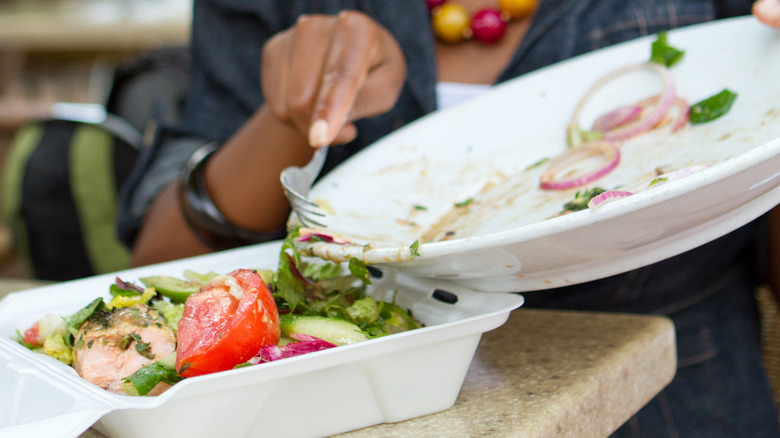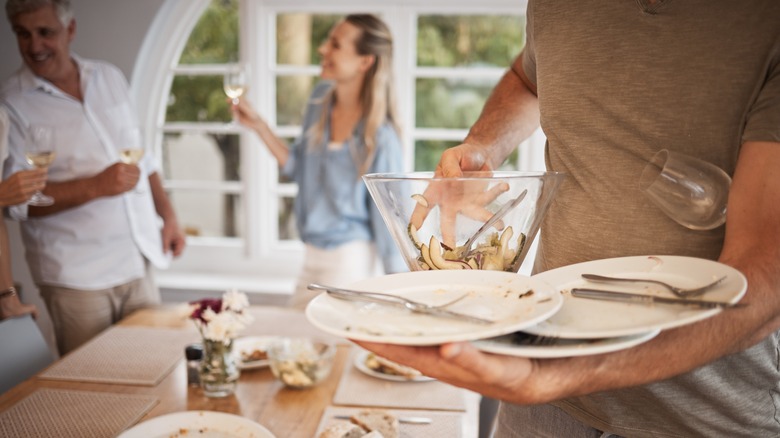Food And Dining Etiquette Rules You Need To Stop Breaking
In an era where embracing a more relaxed style has become increasingly acceptable, the essence of refined dining seems to have gone by the wayside. While we do love to celebrate leaning into what's casual and comfortable (like wearing yoga pants to the grocery store), there's no reason why timeless dining etiquette should fade into obscurity. Instead, it presents an opportunity to revive the elegance and grace inherent in the dining experience.
Dining etiquette doesn't need to be a stuffy thing of the past, but it can be a means to reclaim the true beauty and art that can be found within a dinner shared amongst loved ones. From showing respect to your fellow diners and servers to navigating the meal with grace and charm, at the end of the day, etiquette is really about enjoying the company of others while savoring each bite with sophistication and style. So, let's dust off our finest manners and embark on a journey through the exquisite realm of proper dining decorum.
Pre-cutting your food into bite sized pieces
While this may seem like an obvious one, you would be surprised to know that some adults still pre-cut all of their food at the dinner table. Although it might harken back to the innocent days of youth, refraining from pre-cutting your food adds a touch of sophistication to your dining experience. Not only does it signify self-sufficiency and grace, but there are also several practical benefits to cutting your food as you consume it.
If you are eating a freshly cooked piece of protein, slicing the meat bite by bite will help ensure the remainder stays warm while you eat. Moreover, cutting your food throughout the meal enhances the conversational aspect of dining, allowing you to engage more fully with your companions. As your loved ones share stories, taking time to craft the perfect bite adds to the enjoyment of both the meal and the company. Additionally, cutting your food gradually provides moments of reflection between each mouthful, helping you gauge your satiety levels more accurately. By refraining from pre-cutting your entire meal, you're less likely to overeat and can better appreciate each bite. So, unless you're assisting a young diner, embrace the pleasure of slicing up one delectable bite at a time.
Pass serving dishes to the right
There are few things more enjoyable than a family-style meal surrounded by loved ones. The sight of steaming dishes placed around the dinner table whets our appetites as we prepare to share a nourishing meal with our nearest and dearest. When you go to serve yourself from a piping hot bowl of mashed potatoes, a simple question may arise: Is there a correct way to pass food around the table?
There actually is common etiquette for passing dishes. While some may dismiss this practice as antiquated, understanding the dynamics of this gesture can prevent awkward reaches, accidental spills, and mealtime disruptions. The general rule is to pass to the right. This convention stems from the fact that most individuals prefer holding a dish with their left hand, allowing them to serve themselves with their dominant right hand. While this may not cater to left-handed diners, it remains the traditional norm.
While the default may be passing to the right, always defer to the host's initial choice to ensure harmony at the table.
Know what to do with your napkin
Did you know that the first napkin was actually a chunk of dough? In ancient Greece, a soft dough called apomagdalie served as a tool for cleaning hands at the end of a meal. Fortunately, since then, humans have transitioned to using cloth napkins.
When dining in a more formal setting, you might find yourself curious about the proper etiquette for handling your napkin during the meal. The plethora of napkin etiquette rules at fancy restaurants can be surprising, but the basics are straightforward. Start by unfolding your napkin and placing it gently across your lap when seated (some etiquette guidelines suggest waiting until the host does so). If you need to use your napkin on your face, always employ a light dabbing motion rather than wiping.
Should you need to excuse yourself to the restroom mid-meal, loosely fold the napkin and leave it on your chair, promptly returning it to your lap upon your return. Finally, at the conclusion of the meal, lightly fold your napkin and place it on the table.
Digging in before everyone is served
This rule is generally well-known, but it can become slightly more complex when dining out with a group, especially if everyone's entrées arrive at different times. While proper etiquette dictates waiting until all are served, manners expert Diane Gottsman suggests there's some flexibility here. "A good host and a polite guest knows it's important to wait for everyone to be served," Gottsman told Vogue. "However, a gracious guest that knows everyone else's food is getting cold will not want to hold up the table. She or he will say, 'Please eat, I insist,' and the rest of the table has permission to start."
So, while it's considerate to wait until everyone has been served, in situations where meals are arriving at various times, the best approach is to wait for the individual waiting for their food to give the go-ahead to dig in.
Leave your phone in your bag or pocket
The dinner table isn't the place for texting or scrolling, yet it's become increasingly common to see diners glued to their phones in restaurants. While occasional phone use may be acceptable among close companions, it's generally considered rude to prioritize screens over the person you're sharing a meal with. Dining offers a precious opportunity not only to nourish your body but also to connect with loved ones. Whether you're on a date or catching up with an old friend, the essence of dining lies in being fully present with your food and company.
In today's tech-driven world, the allure of our smartphone is undeniable, with its addictive nature well-documented. However, both proper etiquette and mental well-being discourage phone use during meals. We strongly advocate for the self-discipline needed to fully engage in the dining experience.
If you're dining solo, the temptation to reach for your phone may be even stronger. Instead, we suggest bringing along a book or simply taking a moment to immerse yourself in your meal and surroundings. Your overall sense of well-being will undoubtedly benefit from this mindful approach.
Salt and pepper stick together
Have you ever paused to ponder how the tradition of having salt and pepper on the table became so ubiquitous? While spices have been integral to cooking for centuries, they weren't always made available to diners. Up through 17th-century Europe, salt and pepper were always added in the kitchen — and with a heavy hand, at that. Interestingly, salt shakers didn't emerge until the 20th century, primarily to prevent salt from clumping. Nevertheless, this tradition persists, with salt and pepper shakers adorning tables worldwide.
One enduring yet often overlooked rule of etiquette is to always pass the salt and pepper together. Consider them as an inseparable duo, akin to a well-matched (potentially codependent) pair always traveling side by side. This practice isn't just about tradition; it's also a courteous gesture towards your dining companions. By passing both condiments together, you preemptively fulfill any potential desire for pepper after the request for salt. So, the next time someone asks you to pass the pepper, remember to offer the salt as well.
Stop blowing on your soup
While it may be tempting to blow on a spoonful of piping hot soup to aid in cooling it, etiquette experts would advise against it. While some recommend gently stirring the soup to help lower its temperature, the best etiquette practice is to delicately hold the spoonful above the bowl and allow it to cool before bringing it to your mouth.
While blowing on food may be acceptable in more casual settings, one should refrain from doing so in upscale environments to prevent spills and minimize the spread of germs. When enjoying your soup, opt for gentle sips from the side of the spoon rather than slurping, mimicking how you would sip a beverage. Furthermore, while pairing soup with a piece of bread is undeniably delicious, refrain from dipping the bread into the soup at fancier establishments to avoid creating a mess. Instead, take a bite of bread after sipping the soup from the spoon. Lastly, when nearing the bottom of your bowl, tilt it away from you rather than towards you to consume the remaining broth gracefully.
Taste your food before adding salt
This is a classic rule with potential implications, even extending to hireability! Before delving further, it's important to understand that proper etiquette encourages tasting your food before seasoning it. Not only does this practice enable you to assess the required amount of seasoning accurately, but it also helps avoid inadvertently offending the chef by implying that their dish lacks flavor right off the bat.
According to legend, Henry Ford would assess job candidates over lunch, and those who salted their food before tasting it reportedly didn't receive job offers. While the authenticity of this tale may be uncertain, its underlying message resonates with many. Although occasionally salting a dish before tasting it might be acceptable, etiquette suggests that you should always sample the food first to determine the appropriate level of seasoning. It's a simple yet significant gesture that demonstrates respect for both the chef's expertise and the culinary experience as a whole.
Order conservatively when being hosted
When being treated to a delicious meal, avoid ordering the most expensive thing on the menu. This gesture demonstrates respect and gratitude towards your host. Instead, take a moment to peruse the menu for dishes that pique your interest, ensuring they aren't the priciest options available.
As the meal progresses, when the waiter inquires about additional drinks or desserts, it's courteous to defer to the host's preferences. However, there are a few exceptions to this guideline. If the host suggests dessert or recommends their favorite dish, it allows some flexibility in choosing something slightly more indulgent. For instance, if they enthusiastically endorse the surf and turf, you might consider it as an option.
Moreover, if the host encourages you to order whatever you desire, perhaps in celebration of a birthday or significant achievement, this grants some additional leeway in your selection. Nevertheless, it's essential to stay attuned to your host's demeanor and ask about their intended order before placing your own. This ensures that your choices align with the overall atmosphere and expectations of the dining experience.
Properly place your fork and knife at the end of a meal
When dining out, particularly at upscale establishments, signaling to your server that you've finished your meal can sometimes be perplexing. Where do you put your fork and knife when you're done eating? Fortunately, traditional etiquette provides a helpful method for communicating this to waitstaff. The customary approach involves treating your plate like a clock: Place the handles of your cutlery, typically a fork and knife, at 4 o'clock with the tines or blades angled diagonally at 10 o'clock. Ensure that the fork rests below the knife, and the blade of the knife faces towards you.
While this guideline is generally straightforward, there are some regional variations. In Europe, it's common for the fork to be turned over, whereas in the United States, it should face upwards. Although this practice isn't as widespread today, and some people consider it an archaic restaurant etiquette rule, it remains a generally understood means of indicating to the waitstaff that you've finished your meal.
Be mindful of the pace of your fellow diners and wait until most have finished before positioning your cutlery in this manner, as a sign of respect to everyone at the table.
Be mindful when taking home leftovers
Being treated to a nice meal out is truly delightful. Whether it's a birthday celebration, a toast to a recent promotion, or simply a spontaneous act of kindness from a loved one, dining together is a heartwarming gesture. While we've already discussed the importance of not ordering the most expensive item on the menu (unless, of course, your host insists on treating you to the lobster), there's another lesser-known etiquette tip to bear in mind.
In today's dining landscape, it's common for restaurants to package up any uneaten food for you to take home. While this is generally acceptable, it's important not to give the impression that you're taking advantage of the complimentary leftovers. For instance, intentionally over-ordering at a work lunch with the intention of stretching the meal into dinner might be perceived negatively by your boss.
However, if you've ordered appropriately and find yourself genuinely unable to finish your meal, it may be appropriate to request a leftover box. Of course, this depends on your relationship with the host. As a general guideline, it's wise to be mindful of your host's cues and preferences in these situations to ensure that you don't inadvertently overstep any boundaries.
Return the love
The realm of dining etiquette can indeed be intricate, but amidst its complexities, one simple gesture can sometimes be overlooked: expressing gratitude with a gracious thank you at the end of a meal. This is an especially pertinent etiquette rule at dinner parties. Whether a friend has hosted you for dinner, your boss has treated you to lunch, or your partner has prepared a meal for you, never underestimate the power of expressing appreciation for their efforts.
In a more casual setting, a verbal thank you as the meal concludes suffices. However, if someone has welcomed you into their home and provided a meal, going the extra mile by sending a handwritten thank-you card or flowers in the days following can be a truly meaningful gesture. In a world increasingly dominated by digital interactions, there's an undeniable charm in receiving a heartfelt note written by hand.
Moreover, if your spouse or parent has prepared a weeknight dinner for you, taking the time to express gratitude by helping with the dishes and tidying up is a beautiful way to demonstrate your appreciation. At the end of the day, cooking for someone is a form of showing them love, so be sure to return the energy!

